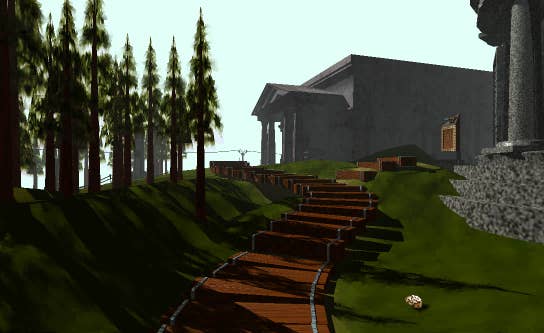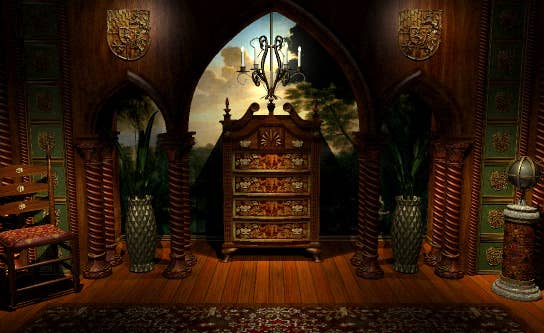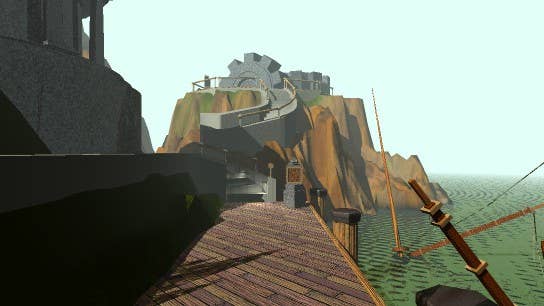Building a Myst-ery | Why I Love
Smart Technologies' Andy Cargile calls Cyan Worlds' seminal puzzle game "moody, magical, and filled to the brim with mysterious mechanisms..."
Why I Love is a series of guest editorials on GamesIndustry.biz intended to showcase the ways in which game developers appreciate each other's work. This entry was contributed by Andy Cargile, lead designer at Smart Technologies, which launched the rogue-like strategy card game The Last Kids on Earth: Hit the Deck last month on PC.
Have you ever been to a movie where it's completely genre-changing and forever memorable? That's happened a few times for me.
It happened in 1977 when I saw Star Wars in the theater. It happened in 1979 when I saw Alien opening night. And it happened again in 1993 when I played Myst. I just remember seeing this beautiful immersive world, and thinking "Oh my god! What do I do? Where's the UI?" I'd never seen anything like it before. What's fascinating is that 20 (nay 30!) years later, it still feels so utterly different from anything else out there.
There's so much I can say about Myst, so let's start at the beginning. Myst features a cold open that simply drops you on a strange island without any idea of who you are or what you should be doing. The game simply trusts you to wander around and figure these things out for yourself.
It's not long before you encounter a library containing two magical books, each imprisoning one of two feuding brothers that have been exiled to a void – represented to the player as staticy live-action FMV recordings on the pages. One brother says to bring him blue pages to free him, the other says to bring him red pages instead. They both say not to trust each other. Oh dear! So already we've got an interesting story predicated on a central question: get to the bottom of this and figure out who's lying. A mystery is afoot!

What's so fascinating here is that the narrative IS the world design. Myst's lore is all about people who harnessed the ability to bring worlds to actual, physical life simply by writing about them (not unlike game developers if you think about it). As such, these worlds ARE the story. Each island (or "age", as is the game's vernacular) is its own self-contained universe with its own way of working. One is centered around an elevator with a host of mechanical puzzles that must be solved to access new areas. I suppose it may seem tame now, but 3D settings were a rarity in 1993, so having a game where you explore a 3D space both horizontally and vertically – and it made logical sense – was rather mind blowing at the time.
Myst's approach to puzzles was similarly inventive. Up until this point adventure games were largely predicated on inventory puzzles. Use A with B, or X on Y. Games like Monkey Island, Maniac Mansion, and Space Quest were constructed with these types of puzzles, yet Myst didn't even contain an inventory! Instead, you had to flip switches and levers and observe what effects they had on your surroundings (something often not immediately clear or within eyesight). Clues were all around you, but you needed to stop, think, and observe.
It felt downright educational as you weren't merely learning to solve a scripted riddle (there's no "use rubber chicken on pulley" puzzle here), but rather thinking critically to understand how a piece of machinery operates.
It helped that the environments were so gorgeously rendered. I could almost see somebody sweating the detail over the grain of the wood fibers, where they're old and chunky in the mill then new and fresh outside. These were environments that begged to be scrutinized.

If Myst were merely dry, mechanical puzzles, that may not have stirred the imagination enough to motivate progression. Instead, these islands were strange and exotic, full of recognizable elements rearranged in a surreal fashion. Myst island itself contained a rocket ship, an ancient Roman looking library, a clock tower built upon a giant gear, and a cozy cabin in a forest. What kind of place is this? It's moody, magical, and filled to the brim with mysterious mechanisms just waiting to be made sense of.
I mentioned earlier that the game's objective is a mystery in and of itself, and never is that more true than of the ending. (Spoilers for a 30 year old game to follow.)
Early on we're told by the two warring brothers to collect red and blue pages to free them. As it turns out, they're both lying, and that's not even the goal at all! The real goal only requires you to find two halves of a note, then know what to do with the reconstructed message. Depending on the order you explore Myst's multiple islands, you could potentially finish the game without even visiting two of the game's five stages. To this day I've never seen a game so boldly leave its "good" ending obscured in plain sight, while the more obvious path leads you to your doom. What a twist!
Special mention should be made for Myst's audio design. These are abandoned islands, so the soundscape is all natural sounds like wind blowing, water trickling, and wood creaking, but we also get plenty of mysterious mechanical sounds when we flip switches and push buttons. These clued us in to these island's mysterious goings on. Musically, Myst's score is also rich and evocative, yet subtle enough not to be overpowering. It was only used sparingly to heighten the sense of awe and danger when encountering something forbidden and private.

Myst was bold, daring, and as different an adventure game as you could imagine in 1993. More importantly, it was so stunningly cohesive. From narrative, to level design, to art direction, to audio, to puzzles, it all made sense together. The puzzles are embedded within the art direction and design of Myst's islands, while these environments tell the game's peculiar story.
Myst rewrote the rules of what an adventure game could be, and even decades later I still feel this twinge of inspiration and awe thinking about the first time I encountered it.
Developers interested in contributing their own Why I Love column are encouraged to reach out to us at news@gamesindustry.biz.
